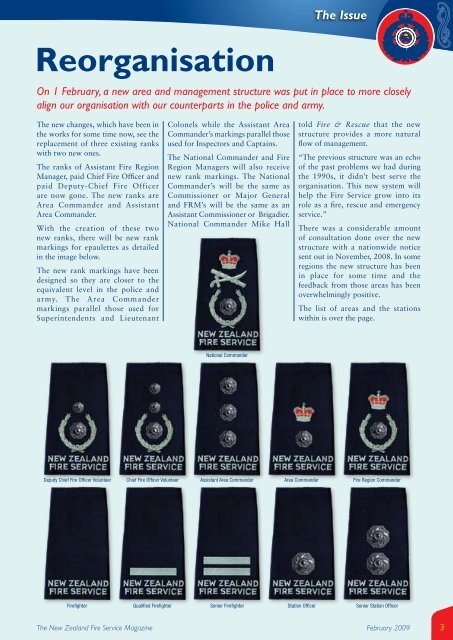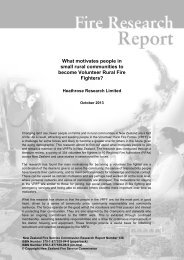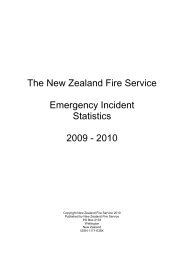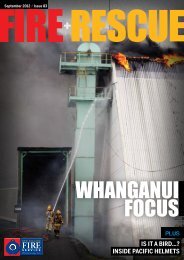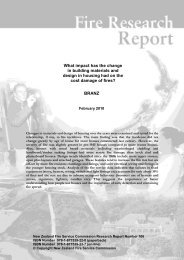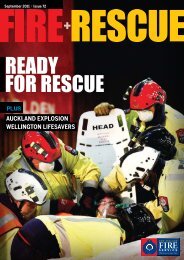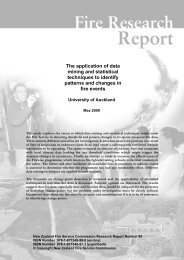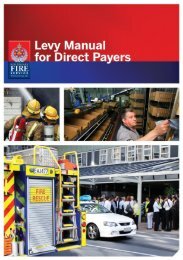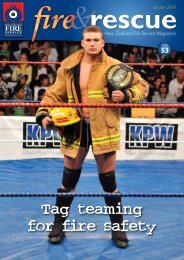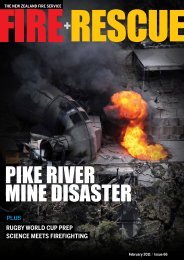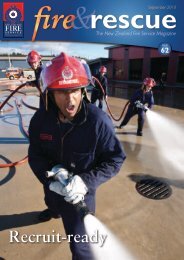Issue 48 - New Zealand Fire Service
Issue 48 - New Zealand Fire Service
Issue 48 - New Zealand Fire Service
You also want an ePaper? Increase the reach of your titles
YUMPU automatically turns print PDFs into web optimized ePapers that Google loves.
Reorganisation<br />
On 1 February, a new area and management structure was put in place to more closely<br />
align our organisation with our counterparts in the police and army.<br />
The new changes, which have been in<br />
the works for some time now, see the<br />
replacement of three existing ranks<br />
with two new ones.<br />
The ranks of Assistant <strong>Fire</strong> Region<br />
Manager, paid Chief <strong>Fire</strong> Officer and<br />
paid Deputy-Chief <strong>Fire</strong> Officer<br />
are now gone. The new ranks are<br />
Area Commander and Assistant<br />
Area Commander.<br />
With the creation of these two<br />
new ranks, there will be new rank<br />
markings for epaulettes as detailed<br />
in the image below.<br />
The new rank markings have been<br />
designed so they are closer to the<br />
equivalent level in the police and<br />
army. The Area Commander<br />
markings parallel those used for<br />
Superintendents and Lieutenant<br />
Deputy Chief <strong>Fire</strong> Officer Volunteer<br />
Colonels while the Assistant Area<br />
Commander’s markings parallel those<br />
used for Inspectors and Captains.<br />
The National Commander and <strong>Fire</strong><br />
Region Managers will also receive<br />
new rank markings. The National<br />
Commander’s will be the same as<br />
Commissioner or Major General<br />
and FRM’s will be the same as an<br />
Assistant Commissioner or Brigadier.<br />
National Commander Mike Hall<br />
National Commander<br />
told <strong>Fire</strong> & Rescue that the new<br />
structure provides a more natural<br />
flow of management.<br />
“The previous structure was an echo<br />
of the past problems we had during<br />
the 1990s, it didn’t best serve the<br />
organisation. This new system will<br />
help the <strong>Fire</strong> <strong>Service</strong> grow into its<br />
role as a fire, rescue and emergency<br />
service.”<br />
There was a considerable amount<br />
of consultation done over the new<br />
structure with a nationwide notice<br />
sent out in November, 2008. In some<br />
regions the new structure has been<br />
in place for some time and the<br />
feedback from those areas has been<br />
overwhelmingly positive.<br />
The list of areas and the stations<br />
within is over the page.<br />
Chief <strong>Fire</strong> Officer Volunteer Assistant Area Commander Area Commander <strong>Fire</strong> Region Commander<br />
<strong>Fire</strong>fighter Qualified <strong>Fire</strong>fighter Senior <strong>Fire</strong>fighter Station Officer Senior Station Officer<br />
The <strong>New</strong> <strong>Zealand</strong> <strong>Fire</strong> <strong>Service</strong> Magazine<br />
The <strong>Issue</strong><br />
February 2009<br />
3


